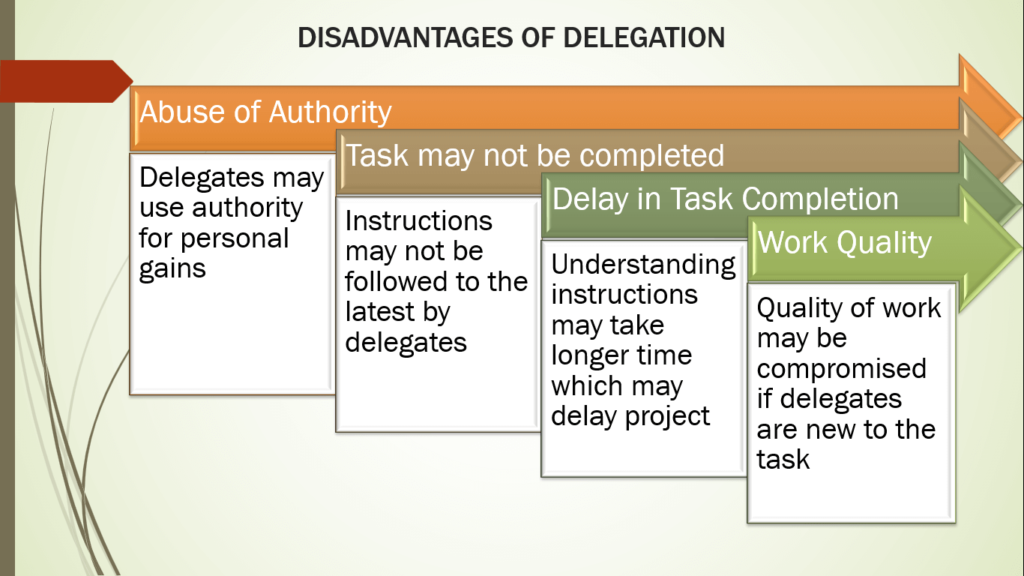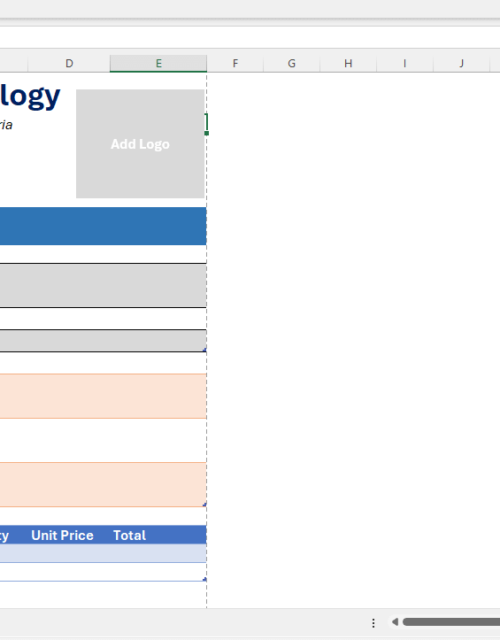Delegation of Authority and Span of Control in Business Management

In business management, there are times authority or responsibility will be devolved to another within the organization. This process is called delegation of authority.
Delegation of authority is a means by which you can transfer duties and responsibilities to another employee. As a business manager, a need may arise that will make you delegate responsibility to your subordinate. This will make your organization become more effective and reduce reliance on you.
The span of control on the other hand is used to refer to the number of employees under a manager’s supervision.
If you are a small business owner with five (5) employees, it is possible that they all report to you. Else, the number of people that reports to you is known as the span of control.
These two terms are frequently used in business management. It is therefore important that every business manager understands the terms. Hence, in this article, I will be discussing the terms delegation of authority and span of control.
This article is written for students, applicants, and anyone involved in business operations.
Table of Contents
What is the Principle of Delegation of Authority?
Delegation is giving someone else the power to carry out certain tasks. One of the fundamental ideas of management leadership is the process of allocating and entrusting tasks to another individual. Managers must decide which tasks they should complete themselves and which ones they should assign to others.
From a managerial perspective, delegation entails transferring project ownership to team members, allowing them to efficiently conclude the work output with little assistance.
Effective delegation is the art and science of giving a task’s performance to a capable subordinate and ensuring that the assignment you’ve been given is finished successfully and on schedule.

Depending on how much authority a supervisor gives to their team members so they can make independent judgments and take action, delegation may be full or partial. In order to effectively delegate authority, a manager may follow the guidelines listed below:
Functional definition principle
The purpose of this principle is to clearly define the tasks that a person must perform. It also focuses on clarity of methods, expectations, goals, and objectives.
Principle of unity of command
This principle states that a subordinate should only report to his superior. This represents a sense of personal responsibility. While it is possible for subordinates to receive and report orders from more superiors, this creates more problems and difficulties. Duties are personal in nature, and delegation of authority to an individual by more than one person can create conflicts of authority and responsibility. This principle also helps us classify the relationship between competence and responsibility.
Principle of delegation based on expected results
This principle states that before delegating authority, managers should first consider the goals to be achieved, and then delegate authority sufficiently to achieve the expected results.
Principle of absolute responsibility
The responsibility of subordinates, once accepted, lies solely with the boss. Once delegated, the supervisor’s responsibility does not diminish. A person can delegate authority, but not responsibility. He remains responsible for the work even if it is delegated to his subordinates. Therefore, the responsibility of superiors and subordinates is absolute.
Principle of equality of powers and responsibilities
According to this principle, administrators should maintain a balance of authority and responsibility. Both should go hand in hand.
According to this principle, subordinates should be given sufficient independence and authority to carry out their work effectively when they are given the responsibility to do so. This principle also does not give undue authority to subordinates. Powers should be granted in a manner appropriate to the tasks entrusted to him. So, there should be no difference between the two.
Privilege level principle
The principle is that decision-making should remain at the level to which authority is delegated. Managers delegate authority to subordinates but tend to be tempted to make decisions on their behalf. Subordinates should be allowed to make their own decisions according to their delegated authority. Delegation of authority is effective only if it is clear and understood by subordinates. Subordinates need to know their own decision-making areas and resist the temptation to refer matters to their superiors.
Scalar principle
The scalar principle refers to the direct chain of authority from superiors to subordinates throughout the organization. Subordinates should have a clear understanding of who should delegate authority and who should delegate matters outside of their authority.
Principle of appropriate motivation
Even with authority, a person may not carry out the responsibilities that a manager assigns to them. This idea enables managers to implement incentives that encourage team members to feel motivated and fulfill their duties in an accountable manner.
Principle of effective control
Supervisors may be better able to gauge team members’ performance when they set up a framework for control. This enables them to assess how someone exercises their authority.
What is the Advantage Of Delegation of Authority In An Organization?
Delegation helps promote efficiency in an organization, the following are some of its advantages.

Enable employees to learn new skills
When a manager delegates tasks outside of his/her normal duties, the person can learn new skills. This skill development allows employees to find their positions and career growth.
Promotes trust in the organization
Employees feel empowered when their managers show confidence in completing specific tasks. Trust fosters strong relationships between leaders and their team members and also improves morale.
It promotes employees accountability
Employees feel more accountable when managers show confidence in their abilities. To maintain that trust, employees demonstrate diligence and ensure that their actions bring good results.
Reduces stress on the managers
Managers often have multiple high-level goals that they must achieve to help the organization achieve its business objectives. Delegating non-essential tasks can help you manage your schedule better and reduce stress.
Increases overall organizational productivity
As managers and teams work better as cohesive units, more projects can be added to the workload. This provides opportunities for growth through increased productivity.
Creates diverse and adaptable workforce
Each team member has strengths in a particular area. By leveraging these strengths while constructively addressing weaknesses at the same time, managers can recruit large numbers of employees for a variety of tasks.
There is improved employee retention
Training and mentoring your team members is an investment in your workforce. The last thing you want is for them to take your order and leave. The delegation will make them feel part of the company and encourage them to look for opportunities within the company rather than elsewhere.
Managers have more time for higher-priority work
Your ultimate job as a manager is to source for projects and keep everything on track. Even if you are an administrator, there are administrative and other tasks that only you can do. Delegate your project work to spend more time on these tasks.
Allows for Innovation
One requires the correct kind of authority and freedom to implement innovative ideas within the business. A person’s ability to think differently may be constrained by a tight framework and a lack of authority. If worthy people are given the proper authority, they could be able to contribute to innovation. The organization may benefit from innovative ideas and positive developments if authority is delegated.
Increases team spirit
Giving a group of people authority strengthens their relationships and mutual understanding. They have the opportunity to cooperate to achieve a common objective, fostering a sense of teamwork.
Can be a tool to test employee skills
With authority comes additional responsibilities that are not easily assumed. You need to be focused and efficient, take initiative, pay attention, think creatively, analyze situations, and make decisions. Evaluating agent performance helps managers evaluate agent performance and make decisions about promotion.
It’s an avenue to provide on-the-job training
Delegations give employees an insight into the real work and provide hands-on vocational training. Delegating authority involves sharing and communicating knowledge to improve the overall awareness and know-how of the delegator’s work. The acquired skills and knowledge are tested on the job and employees are given the opportunity to prove themselves.
It builds trust and understanding between employees and their superiors
Delegating means trusting and relying on someone’s abilities. This helps build a sense of mutual understanding and trust. Managers have the opportunity to understand their employees’ attitudes toward work.
Disadvantages of Delegation of Authority
Let’s look at some disadvantages below.

There could be an abuse of authority
When authority is delegated, there is a risk that the delegator will abuse it for personal gain. He may have access to confidential information and share it with competitors or engage in other fraudulent activities. This possibility raises a question mark regarding employee integrity. In that case, it would be a wrong decision to elect such a person as a proxy.
There are tendencies that tasks may not be completed
The manager’s instructions may not be well followed by the delegates or may not be very strict in following the instructions. This may be due to the agent’s reluctance or incompetence.
There could be delays in the completion of tasks
It may take a long time for the agent to understand their new responsibilities. Due to his authority, his delay in action could hurt the team’s performance. Delays in planning and decision-making may be unacceptable for your organization. Therefore, delegating authority when time is tight is not recommended.
It can impact on quality of work
Quality can be compromised simply because employees are not used to the job. The delegate may lack the experience and knowledge that the manager has. He could make mistakes. His way of working may be different. This can affect the overall quality of your work. Therefore, it is important for managers to understand that their responsibilities do not end with delegation.
What is Decentralization of Authority?
Decentralization is the process through which an organization’s tasks are distributed or delegated away from a central, authoritative location or group, particularly those related to planning and decision-making.
Decentralization is the maximum amount of authority being delegated. Decentralization is an expansion of the delegation process. Decentralization is distributing tasks, accountability, and matching power from the central unit of an organization to nearby regional and local units.
According to Allen, Decentralization is the systematic endeavor to assign all authority to the lowest levels, with the exception of that which can only be exercised at central locations.
In Dale S. Beach‘s words, it refers to bringing the level of authority and decision-making as closely as feasible to that level.
Thus, decentralization is the methodical and scientific transfer of management power to operating-level employees in accordance with their responsibilities.
What is the Centralization of Authority?
Centralization is the act of concentrating all of an organization’s authority, power, and control at its head or core.
Because there is only one point of control in a centralized organization, the powers are concentrated and kept by a small group of individuals or by a single authority, with the rest of the members receiving instructions and carrying out the directives.
The process of centralization is when an organization’s operations, particularly those related to planning, decision-making, and formulating strategy and policies, are concentrated inside a certain geographic location group. By doing this, the organization’s core retains control over key planning and decision-making functions.
Centralization exists within an organization when all or most of the decisions and orders are made from a central source, usually the highest member of the organizational structure. Centralization flows down from the top of the organization and radiates out.
Information flows upward from all parties in the organization, where it is analyzed and synthesized to enable decision-making. Once a decision is made, orders flow from the top of the organization through a process of delegation in which superiors delegate authority to subordinates to carry out specific tasks.
The top-level manages, coordinates, monitors, and evaluates all activities necessary to carry out the mission. The system seeks to leverage potential economies of scale to improve efficiency and increase reliability by reducing the chance of error.
In addition, the level of centralization of an organization is measured based on its hierarchy of authority and level of involvement in the decision-making process.
What is Span of Control?
A span of control is a superior’s manageable number of subordinates. A manager’s area of influence is broader the more subordinates they have under their control.
The total number of direct subordinates that a manager can manage or control is known as the Span of Control. Depending on how sophisticated the work is, a manager may oversee a different number of employees.
The number of employees who answer to a specific manager is referred to as their span of control. This indicates that a manager with five subordinates would have a span of control of five. Businesses strive to put into place the optimal span of control, which is dependent on the work being done. One company might think a certain span of control is appropriate.
A span of control is defined as the number of subordinates a supervisor can control or handle without compromising work efficiency. In other words, the scope of control is defined as the number of employees reporting to the manager who is considered the manager’s scope of control.
There are two dimensions in the Span of Control, namely;
Vertical dimension: This is the real number of direct reports a manager is actually in charge of. This also goes by the name “Span of Control.”
Vertical distance: This indicates how many layers are (in)directly handled. The degree to which the manager’s wishes filter down to the lowest levels of the organization is what is meant by this phrase. Depth of Control is another name for this.
It mostly focuses on how much a manager communicates with the levels of employees under his control. Downward communication may suffer in the absence of a strong leader.
Types of spans of control
There are two types of control spans.
Narrow span of control
With a narrow scope of control, a manager or supervisor supervises and manages a small number of subordinates at a time and primarily requires this type of control when professional work needs to be done.
Narrow spans are associated with hierarchical organizational structures with many reporting levels. Management spends more time supervising their subordinates, providing more opportunities for growth and development.
However, narrower scopes tend to be more expensive as they require a relatively large number of executives to be hired. The oversight nature of hierarchical organizations can also lead to micromanagement and a decline in subordinate authority if abused.
Advantages
- Effectively monitor subordinates in a limited amount of time.
- High level of effective communication between superiors and subordinates
- Subordinates receive instant feedback.
- Subordinates clarify their roles and responsibilities
Disadvantages
- Over-managing your employees can rob them of their innate talent and creativity.
- Extended control hierarchies lead to longer decision-making.
- Poor control hampers cross-functional problem-solving.
The wide span of control
A manager or supervisor supervises and manages many subordinates at the same time when the scope of control is large. Also, if you do iterative work, you need a wider span.
Advantages
- Subordinates are more independent.
- fewer hierarchy levels
- Since the work is repetitive, the chances of making mistakes are very low.
Disadvantages
- Ineffective administration.
- Increased burden on officers.
- Team member roles are not clearly defined.
- Reduced communication between managers and subordinates reduces manager control.
What is Chain of Command?
Every organization needs to have a good hierarchy or administrative structure. Otherwise, it will lead to confusion and several management issues for the organization. A chain of command is an organizational structure that aids in control.
A structural hierarchy inside an organization is known as a chain of command. It outlines who is in charge of what and to whom they should report.
The structure within a firm is referred to as the “chain of command.” The chain of command specifically outlines the hierarchy of authority for decision-making and accountability. On a chain of command structure, the person at the top has the most authority and, as a result, the final say in decisions. the degree to which
The chain of command is the hierarchy of authority in which the leader of an organization directs and controls the activities of the members of the organization below it. The rationale for the chain of command is to enable the coordination of different individuals and groups engaged in task specialization to achieve organizational goals.
Individuals and groups involved in professional work do not always see the big picture. Their efforts must be coordinated by management to achieve their overall goals.
Features and structure of the chain of command
- Ranking: Ranking is an important feature as it clearly defines the rank of employees at different levels. Hierarchies help employees understand their responsibilities within an organization and act accordingly. It creates discipline and helps the organization run smoothly.
- Unity of Command: Leadership unity helps organizations avoid conflict when making decisions. Accountability is defined by decisions, so she is the only person making any given decision. Prevent any kind of conflict in decision-making.
- Accountability: The chain of command provides employees with specific decision-making. This allows people to make decisions on different levels. This makes the whole process smoother as people hold themselves accountable for their decisions.
- Delegation of Authority: A good chain of command clearly defines delegation of authority. This means that people will more easily know who to take orders from and who to order from. For example, a top-level manager can delegate sub-managers the ability to attend meetings on their behalf.
- Management levels: Another important feature is that it helps you maintain different levels of control. There are three levels of leadership within an organization.
Maximum level: Top management sets the organization’s future goals and is involved in planning.
Intermediate: These managers are involved in executing the plan and making changes as necessary.
Low level: These managers track the day-to-day activities of their employees.
Advantages of the chain of command
A good chain of command has several advantages. Some of them are:
- Responsibility: Companies have many responsibilities and it is important to distribute these to their employees. Everyone has individual responsibilities and managers should be held accountable.
- Productivity: An efficient chain of command promotes good workflow and good management, ultimately increasing employee productivity.
- Maintain good relationships internally and externally: It doesn’t just help maintain good employee relationships. You can also build strong relationships with your customers, vendors, and stakeholders. Again, a good chain of command helps employees communicate their roles and authority within the organization.
- Boost employee morale: Another big benefit is that it helps in boosting employee morale as they can talk to their boss about their concerns. A good management system helps employees solve problems properly.
Disadvantages of the chain of command
Having understood the benefits, there are also some possible drawbacks.
- Less collaboration: A major drawback of having a chain of command within an organization is the lack of collaboration due to the people at the top of the hierarchy running the organization. You set the rules, but employees and middle management have a degree of autonomy in their work. In such cases, there may be less cooperation between authority figures and employees.
- Decreased employee empowerment: The chain of command does not allow employees to make decisions in certain situations. As such, it can discourage employees as they are unable to act on their own in certain situations.
- More competition: Another important issue is the potential for increased competition among managers. This is because decision managers may feel that their colleagues are trying to protect and control their employees.
References
Cronen, V., & Pearce, W. B. (1982). The coordinated management of meaning: A theory of communication. In F. E. Dance (Ed.), Human communication theory (pp. 61–89). New York, NY: Harper & Row.
Leavitt, H., & Mueller, R. (1951). Some effects of feedback on communication. Human Relations, 4, 401–410.
McLean, S. (2005). The basics of interpersonal communication (p. 10). Boston, MA: Allyn & Bacon.
Pearce, W. B., & Cronen, V. (1980). Communication, action, and meaning: The creating of social realities. New York, NY: Praeger.
Kreitner, R. & Cassidy, C. (2008). Management. South-Western College Pub.
Meier, K. J. & Bohte, J. (2000). Ode to Luther Gulick: Span of control and organizational performance. Administration & Society, 32(2), 115-137.
Ouchi, W. & Dowling, J. (1974). Defining Span of Control. Administrative Sciences Quarterly, Vol 19, 1974.
Urwick, L. F. (1922). The manager’s span of control. Harvard Business Review, 34(3). Van Vrekhem, F. (2015). The disruptive competence. The journey to a sustainable business, from matter to meaning. Compact Publishing.











